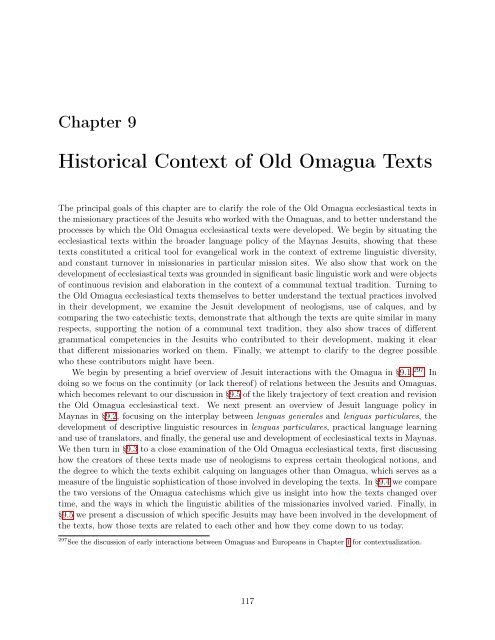draft manuscript - Linguistics - University of California, Berkeley
draft manuscript - Linguistics - University of California, Berkeley
draft manuscript - Linguistics - University of California, Berkeley
Create successful ePaper yourself
Turn your PDF publications into a flip-book with our unique Google optimized e-Paper software.
Chapter 9<br />
Historical Context <strong>of</strong> Old Omagua Texts<br />
The principal goals <strong>of</strong> this chapter are to clarify the role <strong>of</strong> the Old Omagua ecclesiastical texts in<br />
the missionary practices <strong>of</strong> the Jesuits who worked with the Omaguas, and to better understand the<br />
processes by which the Old Omagua ecclesiastical texts were developed. We begin by situating the<br />
ecclesiastical texts within the broader language policy <strong>of</strong> the Maynas Jesuits, showing that these<br />
texts constituted a critical tool for evangelical work in the context <strong>of</strong> extreme linguistic diversity,<br />
and constant turnover in missionaries in particular mission sites. We also show that work on the<br />
development <strong>of</strong> ecclesiastical texts was grounded in significant basic linguistic work and were objects<br />
<strong>of</strong> continuous revision and elaboration in the context <strong>of</strong> a communal textual tradition. Turning to<br />
the Old Omagua ecclesiastical texts themselves to better understand the textual practices involved<br />
in their development, we examine the Jesuit development <strong>of</strong> neologisms, use <strong>of</strong> calques, and by<br />
comparing the two catechistic texts, demonstrate that although the texts are quite similar in many<br />
respects, supporting the notion <strong>of</strong> a communal text tradition, they also show traces <strong>of</strong> different<br />
grammatical competencies in the Jesuits who contributed to their development, making it clear<br />
that different missionaries worked on them. Finally, we attempt to clarify to the degree possible<br />
who these contributors might have been.<br />
We begin by presenting a brief overview <strong>of</strong> Jesuit interactions with the Omagua in §9.1. 297 In<br />
doing so we focus on the continuity (or lack there<strong>of</strong>) <strong>of</strong> relations between the Jesuits and Omaguas,<br />
which becomes relevant to our discussion in §9.5 <strong>of</strong> the likely trajectory <strong>of</strong> text creation and revision<br />
the Old Omagua ecclesiastical text. We next present an overview <strong>of</strong> Jesuit language policy in<br />
Maynas in §9.2, focusing on the interplay between lenguas generales and lenguas particulares, the<br />
development <strong>of</strong> descriptive linguistic resources in lenguas particulares, practical language learning<br />
and use <strong>of</strong> translators, and finally, the general use and development <strong>of</strong> ecclesiastical texts in Maynas.<br />
We then turn in §9.3 to a close examination <strong>of</strong> the Old Omagua ecclesiastical texts, first discussing<br />
how the creators <strong>of</strong> these texts made use <strong>of</strong> neologisms to express certain theological notions, and<br />
the degree to which the texts exhibit calquing on languages other than Omagua, which serves as a<br />
measure <strong>of</strong> the linguistic sophistication <strong>of</strong> those involved in developing the texts. In §9.4 we compare<br />
the two versions <strong>of</strong> the Omagua catechisms which give us insight into how the texts changed over<br />
time, and the ways in which the linguistic abilities <strong>of</strong> the missionaries involved varied. Finally, in<br />
§9.5 we present a discussion <strong>of</strong> which specific Jesuits may have been involved in the development <strong>of</strong><br />
the texts, how those texts are related to each other and how they come down to us today.<br />
297 See the discussion <strong>of</strong> early interactions between Omaguas and Europeans in Chapter 1 for contextualization.<br />
117
















